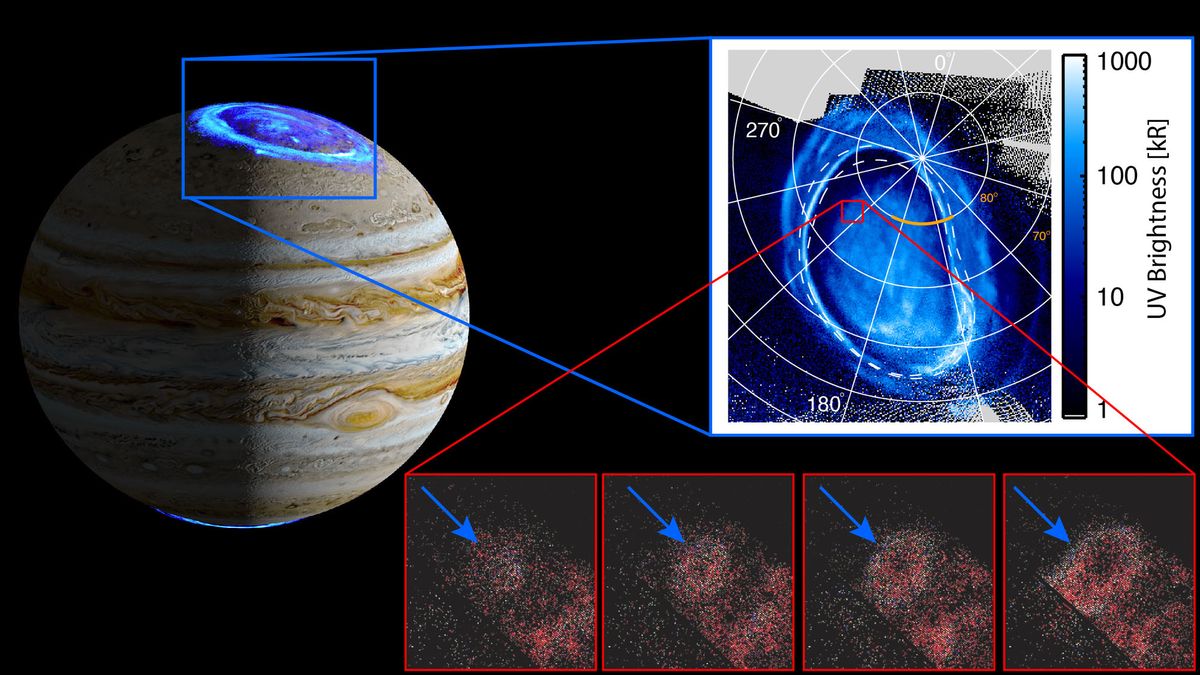
NASA’s Juno mission has detected new auroral emissions on Jupiter that appear to be hovering over the planet’s poles.
The Ultraviolet Spectrograph (UVS) on the Juno spacecraft captured this glowing phenomenon, characterized by faint annular emissions that expand rapidly over time at speeds between 2 and 4.8 miles per second (3.3 and 7.7 kilometers per second ). Researchers from the Southwest Research Institute (SwRI), where Juno’s UVS instrument was built, suggest that this aural emission is caused by charged particles coming from the edge of Jupiter’s massive magnetosphere, according to a statement from the institute.
“We think these newly discovered faint ultraviolet properties are millions of miles from Jupiter, near the Jovian magnetosphere’s boundary with the solar wind,” Vincent Hue, lead author of the study, said in the statement. “The solar wind is a supersonic stream of charged particles emitted by the sun. When they reach Jupiter, they interact with the magnetosphere in a way that is not yet well understood.”
Related: Glowing ‘dawn storm’ auroras blazing in the morning sky of Jupiter are born in darkness
Just like on Earth, auras on Jupiter are linked to charged particles within the planet’s magnetosphere. However, Jupiter’s magnetosphere is about 20,000 times stronger than Earth’s, which means that the gas giant can divert incoming solar winds up to 6 million km away.
“The location of the rings at a high latitude indicates that the particles causing the emissions come from the Jovian magnetosphere, near its boundary with the solar wind,” said Bertrand Bonfond, co-author of the study of the Belgian Liege University, said statement.
The charged particles recorded by Juno’s UVS instrument appear to come from the outer parts of the magnetosphere, where plasma from the solar wind interacts with the Jovian plasma. In turn, this interaction can trigger the ring-like features known as Kelvin-Helmholtz instabilities, which can move along Jupiter’s magnetic field lines. Alternatively, the newly detected auroral feature may be due to magnetic reconnection events along the day, during which interplanetary magnetic fields converge, rearrange, and reconnect, according to the statement.

“Despite decades of observations from Earth, along with numerous in-situ spacecraft measurements, scientists still do not understand the role that the solar wind plays in moderating Jupiter’s auroral emissions,” said Thomas Greathouse, co-author of the SwRI study. said in the statement. . “Jupiter’s magnetospheric dynamics, the motion of charged particles within its magnetosphere, are largely controlled by Jupiter’s 10-hour rotation, the fastest in the solar system. The role of the solar wind is still debated.”
Therefore, the researchers argue that further research is needed to fully understand the processes that these newly detected ring-like emissions produce. With NASA’s Juno mission recently extended to 2025, researchers hope to study the auroral properties of Jupiter in even greater detail.
Their findings were published on March 9 in the Journal of Geophysical Research: Space Physics.
Follow Samantha Mathewson @ Sam_Ashley13. Follow us on Twitter @Spacedotcom and on Facebook.
